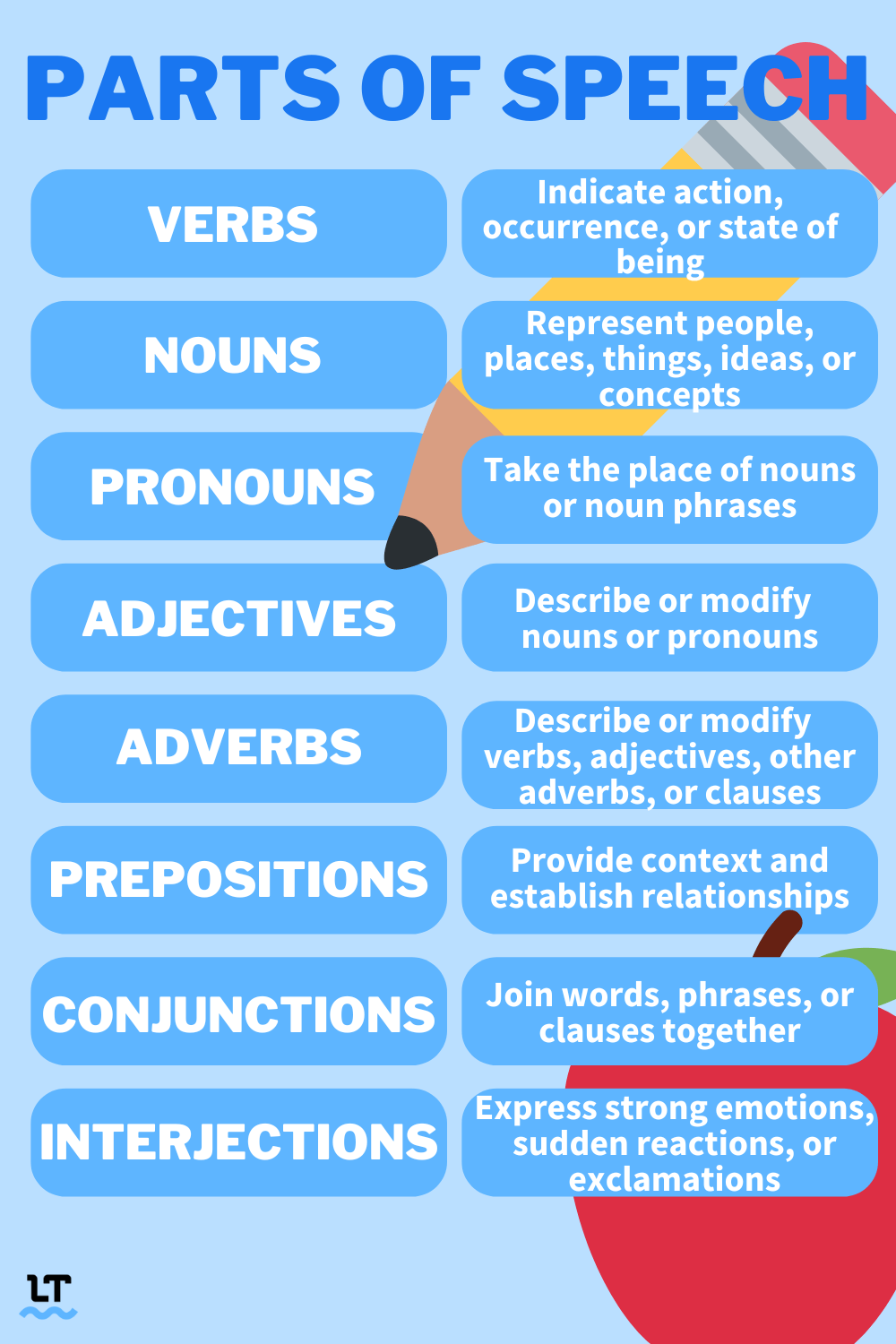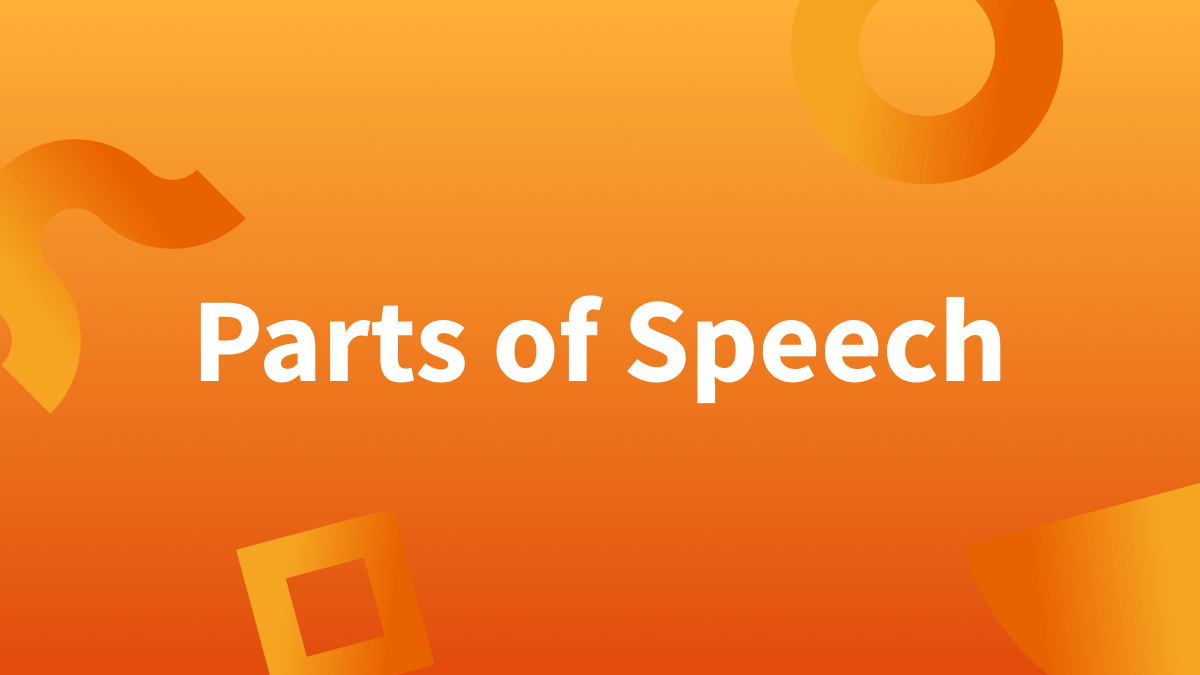Parts of Speech: Quick Summary
Parts of speech assign words to different categories. There are eight different types in English. Keep in mind that a word can belong to more than one part of speech.
Learn About:
Knowing the Parts of Speech Is Vital When Learning a New Language
When it comes to learning a new language, there are several components you should understand to truly get a grasp of the language and speak it fluently.
It’s not enough to become an expert in just one area. For instance, you can learn and memorize all the intricate grammar rules, but if you don’t practice speaking or writing colloquially, you will find it challenging to use that language in real time.
Conversely, if you don’t spend time trying to learn the rules and technicalities of a language, you’ll also find yourself struggling to use it correctly.
Think of it this way: Language is a tasty, colorful, and nutritious salad. If you fill your bowl with nothing but lettuce, your fluency will be bland, boring, and tasteless. But if you spend time cultivating other ingredients for your salad—like style, word choice, and vocabulary— then it will become a wholesome meal you can share with others.
In this blog post, we’re going to cover one of the many ingredients you’ll need to build a nourishing salad of the English language—the parts of speech.
Let’s get choppin’!
What Are the Parts of Speech in English?
The parts of speech refer to categories to which a word belongs. In English, there are eight of them : verbs , nouns, pronouns, adjectives, adverbs, prepositions, conjunctions, and interjections.
Many English words fall into more than one part of speech category. Take the word light as an example. It can function as a verb, noun, or adjective.
Verb: Can you please light the candles?
Noun: The room was filled with a dim, warm light.
Adjective: She wore a light jacket in the cool weather.
The parts of speech in English are extensive. There’s a lot to cover in each category—much more than we can in this blog post. The information below is simply a brief overview of the basics of the parts of speech. Nevertheless, the concise explanations and accompanying example sentences will help you gain an understanding of how to use them correctly.

What Are Verbs?
Verbs are the most essential parts of speech because they move the meaning of sentences along.
A verb can show actions of the body and mind (jump and think), occurrences (happen or occur), and states of being (be and exist). Put differently, verbs breathe life into sentences by describing actions or indicating existence. These parts of speech can also change form to express time, person, number, voice, and mood.
There are several verb categories. A few of them are:
A few examples of verbs include sing (an irregular action verb), have (which can be a main verb or auxiliary verb), be, which is a state of being verb, and would (another auxiliary verb).
My little sister loves to sing.
I have a dog and her name is Sweet Pea.
I will be there at 5 P.M.
I would like to travel the world someday.
Again, these are just the very basics of English verbs. There’s a lot more that you should learn to be well-versed in this part of speech, but the information above is a good place to start.
What Are Nouns?
Nouns refer to people (John and child), places (store and Italy), things (firetruck and pen), and ideas or concepts (love and balance). There are also many categories within nouns. For example, proper nouns name a specific person, place, thing, or idea. These types of nouns are always capitalized.
Olivia is turning five in a few days.
My dream is to visit Tokyo.
The Supreme Court is the highest court in the United States.
Some argue that Buddhism is a way of life, not a religion.
On the other hand, common nouns are not specific to any particular entity and are used to refer to any member of a general category.
My teacher is the smartest, most caring person I know!
I love roaming around a city I’ve never been to before.
This is my favorite book, which was recommended to me by my father.
There’s nothing more important to me than love.
Nouns can be either singular or plural. Singular nouns refer to a single entity, while plural nouns refer to multiple entities.
Can you move that chair out of the way, please? (Singular)
Can you move those chairs out of the way, please? (Plural)
While many plural nouns are formed by adding an “–s” or “–es,” others have irregular plural forms, meaning they don’t follow the typical pattern.
There was one woman waiting in line.
There were several women waiting in line.
Nouns can also be countable or uncountable. Those that are countable refer to nouns that can be counted as individual units. For example, there can be one book, two books, three books, or more. Uncountable nouns cannot be counted as individual units. Take the word water as an example. You could say I drank some water, but it would be incorrect to say I drank waters. Instead, you would say something like I drank several bottles of water.
What Are Pronouns?
A pronoun is a word that can take the place of other nouns or noun phrases. Pronouns serve the purpose of referring to nouns without having to repeat the word each time. A word (or group of words) that a pronoun refers to is called the antecedent.
Jessica went to the store, and she bought some blueberries.
In the sentence above, Jessica is the antecedent, and she is the referring pronoun. Here’s the same sentence without the proper use of a pronoun:
Jessica went to the store, and Jessica bought some blueberries.
Do you see how the use of a pronoun improves the sentence by avoiding repetitiveness?
Like all the other parts of speech we have covered, pronouns also have various categories.
Personal pronouns replace specific people or things: I, me, you, he, she, him, her, it, we, us, they, them.
When I saw them at the airport, I waved my hands up in the air so they could see me.
Possessive pronouns indicate ownership: mine, ours, yours, his, hers, theirs, whose.
I think that phone is hers.
Reflexive pronouns refer to the subject of a sentence or clause. They are used when the subject and the object of a sentence refer to the same person or thing: myself, yourself, himself, herself, itself, ourselves, yourselves, themselves.
The iguanas sunned themselves on the roof of my car.
Intensive pronouns have the same form as reflexive pronouns and are used to emphasize or intensify the subject of a sentence.
I will take care of this situation myself.
Indefinite pronouns do not refer to specific individuals or objects but rather to a general or unspecified person, thing, or group. Some examples include someone, everybody, anything, nobody, each, something, and all.
Everybody enjoyed the party. Someone even said it was the best party they had ever attended.
Demonstrative pronouns are used to identify or point to specific pronouns: this, that, these, those.
Can you pick up those pens off the floor?
Interrogative pronouns are used to ask questions and seek information: who, whom, whose, which, what.
Who can help move these heavy boxes?
Relative pronouns connect a clause or a phrase to a noun or pronoun: who, whom, whose, which, that, what, whoever, whichever, whatever.
Christina, who is the hiring manager, is the person whom you should get in touch with.
Reciprocal pronouns are used to refer to individual parts of a plural antecedent. They indicate a mutual or reciprocal relationship between two or more people or things: each other or one another.
The cousins always giggle and share secrets with one another.
What Are Adjectives?
Adjectives modify nouns or pronouns, usually by describing, identifying, or quantifying them. They play a vital role in adding detail, precision, and imagery to English, allowing us to depict and differentiate the qualities of people, objects, places, and ideas.
The blue house sticks out compared to the other neutral-colored ones. (Describes)
That house is pretty, but I don’t like the color. (Identifies)
There were several houses I liked, but the blue one was unique. (Quantifies)
We should note that identifying or quantifying adjectives are also referred to as determiners. Additionally, articles (a, an, the) and numerals (four or third) are also used to quantify and identify adjectives.
Descriptive adjectives have other forms (known as comparative and superlative adjectives) that allow for comparisons. For example, the comparative of the word small is smaller, while the superlative is smallest.
Proper adjectives (which are derived from proper nouns) describe specific nouns. They usually retain the same spelling or are slightly modified, but they’re always capitalized. For example, the proper noun France can be turned into the proper adjective French.
What Are Adverbs?
Adverbs are words that modify or describe verbs, adjectives, other adverbs, or entire clauses. Although many adverbs end in “–ly,” not all of them do. Also, some words that end in “–ly” are adjectives, not adverbs (lovely).
She dances beautifully.
In the sentence above, beautifully modifies the verb dances.
We visited an extremely tall building.
Here, the adverb extremely modifies the adjective tall.
He had to run very quickly to not miss the train.
The adverb very modifies the adverb quickly.
Interestingly, the experiment yielded unexpected results that left us baffled.
In this example, the word interestingly modifies the independent clause that comprises the rest of the sentence (which is why they’re called sentence adverbs).
Like adjectives, adverbs can also have other forms when making comparisons. For example:
strongly, more strongly, most strongly, less strongly, least strongly
What Are Prepositions?
Prepositions provide context and establish relationships between nouns, pronouns, and other words in a sentence. They indicate time, location, direction, manner, and other vital information. Prepositions can fall into several subcategories. For instance, on can indicate physical location, but it can also be used to express time.
Place the bouquet of roses on the table.
We will meet on Monday.
There are many prepositions. A few examples include: about, above, across, after, before, behind, beneath, beside, during, except, for, from, in, inside, into, like, near, of, off, onto, past, regarding, since, through, toward, under, until, with, without.
Prepositions can contain more than one word, like according to and with regard to.
What Are Conjunctions?
Conjunctions are words that join words, phrases, or clauses together within a sentence and provide information about the relationship between those words. There are different types of conjunctions.
Coordinating conjunctions connect words, phrases, or clauses of equal importance: and, but, for, not, or, so, yet.
I like to sing, and she likes to dance.
Correlative conjunctions come in pairs and join balanced elements of a sentence: both…and, just as…so, not only…but also, either…or, neither…nor, whether…or.
You can either come with us and have fun, or stay at home and be bored.
Subordinating conjunctions connect dependent clauses to independent clauses. A few examples include: after, although, even though, since, unless, until, when, and while.
They had a great time on their stroll, even though it started raining and they got soaked.
Conjunctive adverbs are adverbs that function as conjunctions, connecting independent clauses or sentences. Examples of conjunctive adverbs are also, anyway, besides, however, meanwhile, nevertheless, otherwise, similarly, and therefore.
I really wanted to go to the party. However, I was feeling sick and decided to stay in.
I really wanted to go to the party; however, I was feeling sick and decided to stay in.
What Are Interjections?
Interjections are words that express strong emotions, sudden reactions, or exclamations. This part of speech is usually a standalone word or phrase, but even when it is part of a sentence, it does not relate grammatically to the rest of .
There are several interjections. Examples include: ahh, alas, bravo, eww, hello, please, thanks, and oops.
Ahh! I couldn’t believe what was happening.
Using the Parts of Speech Correctly In Your Writing
When it comes to improving your writing skills, understanding the parts of speech is as important as adding other ingredients besides lettuce to a salad.
The information provided above is indeed extensive, but it’s critical to learn if you want to write effectively and confidently. LanguageTool—a multilingual writing assistant—makes comprehending the parts of speech easy by detecting errors as you write.
Give it a try—it’s free!

